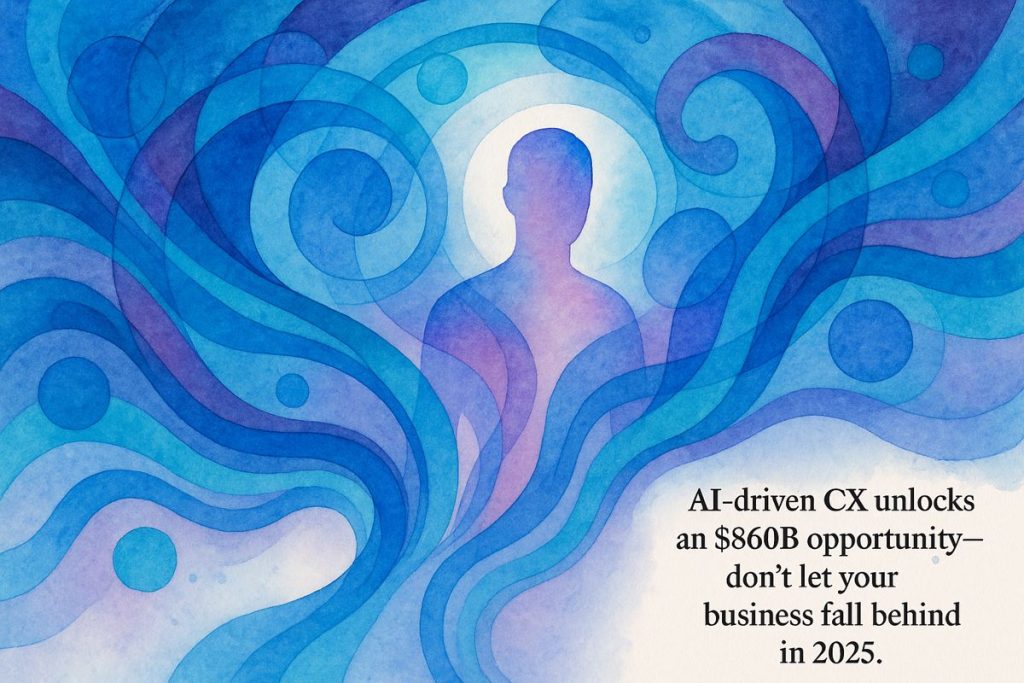In 2025, AI is shaking up how companies treat their customers, creating a huge $860 billion chance for those who dive in. With smart AI tools, businesses can give each person special attention, solve problems before they get big, and make every step smooth—leading to loyal, happy customers. But if companies wait too long, they could lose their place in a $4 trillion market, as customers quickly move to brands that “get” them. The game is changing fast, and only those who adapt will thrive in this new world.
What is the impact of AI on customer experience in 2025?
AI is transforming customer experience in 2025, unlocking an $860 billion opportunity. Companies adopting AI-powered platforms achieve real-time personalization, seamless omnichannel journeys, and proactive support through virtual agents, increasing loyalty and revenue. Those who delay risk losing relevance in a $4 trillion global CX market.
The aroma of burnt espresso clung to my office as I pored over the latest CX reports—an odd comfort. Everyone’s talking about AI these days, but 2025 feels different, doesn’t it? We’ve hit a zeitgeist moment, where the potential of AI in customer experience isn’t just a shiny talking point but a tangible, if somewhat slippery, $860 billion opportunity (according to Qualtrics). That’s not pocket change; it’s an economic moonshot waiting for someone (maybe you?) to assemble the puzzle pieces.
The High Stakes of Modern CX
Let’s get concrete: nearly $4 trillion in global business is precariously balanced on the fulcrum of customer and employee experience. It’s not just theory or hype; Qualtrics’ research spells out the numbers. If you squint, you can almost see the lost revenue drifting away, like so many post-it notes from a desk fan. The $860 billion AI windfall is less a lottery ticket, more an urgent memo: adapt, or join the ranks of Blockbuster and Borders.
What’s fueling this? The answer is simple—money talks. CEOs are done with pilot purgatory, tired of dabbling with proofs of concept that never scale. Why? Because the alternative looks a lot like irrelevance. You can stay in the shallow end, but eventually, someone’s going to cannonball into the deep and send waves across your business. I’ll admit, I once thought a “wait and see” approach was shrewd. Turns out, it’s just another way to lose quietly.
But let’s not pretend AI is a magic wand. It’s more like a hyperspectral lens, exposing hidden patterns in the palimpsest of transactions, reviews, and digital detritus left behind by customers. If that sounds a bit poetic, well, sometimes numbers require a touch of poetry.
The Strange Case of Customer Loyalty
Now, here’s a paradox: even as negative experiences decline, so does loyalty. The 2025 Consumer Experience Trends from Qualtrics serve up this uncomfortable truth. Customers are less forgiving—one poorly handled chat, and poof, they’re out the door. Like a soufflé that collapses at the faintest slam, brand relationships have gotten fragile.
And feedback? Ahem, have you checked your survey response rates lately? They’ve hit all-time lows, a veritable flatline on the dashboard. We’re now forced to listen for the faintest signals—the digital equivalent of a dog’s ears perking up at a distant sound. Advanced AI is tasked with decoding these whispers, catching micro-changes in sentiment or preference that humans would miss. I sometimes wonder: is the age of the “big, annual survey” over? Probably. And good riddance—it always felt a bit like asking someone at a party if they’re having fun, rather than just watching whether they go back for more cake.
I felt a pang of nostalgia when I remembered the first feedback form I ever built—clunky, overlong, and ignored. Lesson learned: if you want useful data, you’d better learn to read between the lines.
Platform Powerhouses and the Omnichannel Mandate
This AI revolution isn’t being built on dreams alone. It’s grounded in the cold steel of enterprise platforms like Salesforce and SAP. These names ring out in boardrooms, whispered like minor deities. If you haven’t seen SAP’s new “composable customer experience suite,” you’re missing an omnichannel symphony—data streams unifying in real time, orchestrating personalized journeys that would make even a Tolstoy novel seem linear (details here).
But let’s ground this: at the Qualtrics X4 2025 summit, the debut of “Experience Agents”—AI-powered virtual helpers—brought a whiff of science fiction to the conference hall. These agents listen, anticipate, and, crucially, resolve issues before they combust. It’s like having a chess grandmaster and a barista in your customer chat: strategic and somehow comforting. I had to pause and wonder—will humans resent being replaced by algorithms this attentive? Maybe. Or perhaps we’ll just enjoy fewer “please hold” jazz loops.
Forrester’s coverage of Qualtrics Edge highlights another leap—a platform distilling oceans of data into drinkable insights. It’s the analytical equivalent of cold brew: intense, complex, and slightly addictive.
Early Adopters and the Reluctant Majority
The early birds aren’t just catching worms—they’re catching market share. These firms move beyond sandbox experiments and wire AI into the company’s very nervous system. Data is fused across silos; mundane tasks are handed off to tireless digital workers; every customer touchpoint is tuned for context and continuity. I once watched a pharma client—initially skeptical, almost dismissive—turn into an AI champion after seeing what real-time personalization could do for physician engagement. The look of astonishment (and relief) on their face? Priceless.
Yet, not everyone’s sprinting ahead. Plenty of organizations are stuck in wait-and-see mode, haunted by fears of botched privacy, patchy compliance, or the “uncanny valley” of tone-deaf AI. Who can blame them
